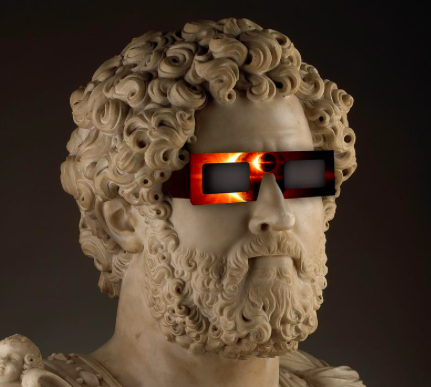Art World
From Kara Walker to Laurie Simmons, the Art World Got Creative With the Eclipse on Social Media
From profound to goofy, artists and other art-world folks riffed on the astronomical event.

From profound to goofy, artists and other art-world folks riffed on the astronomical event.

Brian Boucher

Spellbound crowds gathered across the United States on Monday to view one of nature’s more dramatic shows: a solar eclipse. Some donned 3-D-like glasses that allowed them to stare directly at the sun; others made do with makeshift boxes or cardboards pricked with pinholes to project an image of the eclipsed sun onto the ground or paper. Whether standing in the “path of totality” (where the moon completely covered the sun) or in New York City (where the sun became a crescent), denizens of the art world were among those tuning in. Some of their social media reactions revealed the kind of eye for aesthetics that lead people to the art world in the first place.
New York artist Kara Walker found, by looking down, an echo of what we would all soon see by looking up:
https://www.instagram.com/p/BYCW1rGl5gj/
Parts of the West Coast went dark first; San Francisco dealer Jessica Silverman was there, snapping an artful photo:
On the East Coast, New York artist Stacey Leigh also smartly documented the eclipse itself:
Cell phone eclipse stuffs:No filter! But I put my eclipse glasses over my cell phone camera, for the video.
Posted by Stacy Leigh on Monday, August 21, 2017
Many observers were struck by the crescents formed by simple devices like a colander as they projected the image of the partly obscured sun. Stuart Comer, chief curator of media and performance art at New York’s Museum of Modern Art, noted it with elegance:
The Hammer Museum in Los Angeles found poetry in a single fallen leaf, contrasted against a pattern of those crescent shapes:
New York artist Laurie Simmons made a statement with a simple zoom of the camera:
Today wasn’t the first time artists had heard of solar eclipses or treated the burning orb that our Earth revolves around. New York’s High Line Arts took the opportunity to remind us of a sun-related performance work by Eduardo Navarro:
Dealer Adam Lindemann, of Venus Over Manhattan and Venus Over Los Angeles, recalled a 1980s work by Jack Goldstein that emphasized haze over focus:
Kimberly Drew, of New York’s Metropolitan Museum of Art, drew on artist Alma Thomas’s lush depiction of our sun, unusual for its deep blue hue at the sun’s center:
Others looked much farther back—more than 500 years back in the case of Lynley Herbert, assistant curator of rare books and manuscripts at Baltimore’s Walters Museum:
Image of a solar eclipse in Walters W.199, dated 1489. There, now you don't need to worry about special glasses!https://t.co/U2hxeF6qEU pic.twitter.com/crVzMY0W9e
— Lynley Herbert (@Lynley_Herbert) August 21, 2017
Pittsburgh’s Andy Warhol Museum pulled from the archives a lovely undated drawing by the master:
It's peak #eclipse time here in #Pittsburgh!
Andy Warhol, "Sun with Face", n.d., © AWF #eclipse #sun #SolarEclipse2017 #art #andywarhol pic.twitter.com/qhHMYc0o4Y— Andy Warhol Museum (@TheWarholMuseum) August 21, 2017
New York’s Jack Shainman promoted one of its artists, posting a wall sculpture by El Anatsui whose reference to an eclipse might not be immediately obvious:
Some couldn’t help but get a little political. New York dealer and fair organizer Ed Winkleman tapped into a meme that spread like wildfire:
This literally happened.Trump looking AT the sun during an eclipse.
Posted by Edward Winkleman on Monday, August 21, 2017
Bay Area artist Aaron Gach superimposed some political symbolism on the twin orbs putting on the big show in the sky:
It's happening! The Great American Eclipse! We're approaching totality! Just a little more to go and we're there! (And this time it won't be for just a fleeting moment.) #permanentlyeclipsefascism
Posted by Aaron Gach on Monday, August 21, 2017
Keeping it neutral and staying with the science, New York artist Casey Gollan reminded us of the astronomical speed at which the event was happening:
A shadow is passing across the country at 1,200 to 1,800 miles per hour
— Casey Gollan (@CaseyG) August 21, 2017
And, of course, art world jokesters were on the job. One account that parodies New York magazine scribe Jerry Saltz partook of another popular meme, with social media users “blocking” the sun’s social media accounts:
https://instagram.com/p/BYEqOA5FcOX/
Not everyone was able to secure a pair of eclipse-viewing glasses. DIS Magazine suggested a tongue-in-cheek substitute:
And the Clark Art Institute, in Williamstown, Massachusetts, got involved by mashing up the phenomenon of the eclipse with the mythical medusa.
Saw it. Nobody told me that looking at #eclipse2017 would turn me to stone. #clarkart pic.twitter.com/MNwu0AAYi9
— Clark Art Institute (@the_clark) August 21, 2017
And now, set your watches: The next solar eclipse visible from the US will take place in 2024.